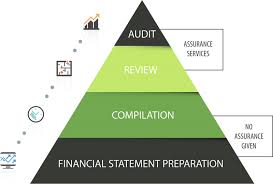Reviewed Financials Statements
Reviewed Financials Provide Limited Assurance on Accuracy of Financial prepare by a CPA with the purpose of expressing an opinion on financial statements.
Purpose of Reviewed Financials:
- Intended to provide lenders and other outside parties with a basic level of
- assurance on the accuracy of financial statements
- Typically, appropriate as a business grows and is seeking larger and more
- complex levels of financing and credit
- CPA issues review report
A financial statement review is a service under which the accountant obtains limited assurance that there are no material modifications that need to be made to an entity’s financial statements for them to be in conformity with the applicable financial reporting framework (such as GAAP or IFRS). A review does not require the accountant to obtain an understanding of internal control, or to assess fraud risk, or other types of audit procedures. Consequently, a review does not provide the accountant with the assurance that he has become aware of all the significant matters that would normally have been discovered and disclosed in an audit.
The review is more expensive than a compilation and less expensive than an audit. It is preferred by those businesses whose lenders and creditors will allow them to use this approach, thereby saving the cost of a full audit.
In a review, management takes responsibility for the preparation and presentation of the entity’s financial statements, while the accountant should have a sufficient level of knowledge of both the industry and the entity to review the financial statements.
In a financial statement review, the accountant performs those procedures necessary to provide a reasonable basis for obtaining limited assurance that no material changes are needed to bring the financial statements into compliance with the applicable financial reporting framework. These procedures are more heavily concentrated in areas where there are enhanced risks of misstatement. The types of procedures that would be reasonable to conduct for a review include:
Conduct a ratio analysis with historical, forecasted, and industry results
Investigate findings that appear to be inconsistent
Inquire about the procedures for recording accounting transactions
Investigate unusual or complex situations that may impact reported results
Investigate significant transactions occurring near the end of the accounting period
Follow up on questions that arose during previous reviews
Inquire about material events that occurred after the date of the financial statements
Investigate significant journal entries
Review communications from regulatory agencies
Read the financial statements to see if they appear to conform with the applicable financial reporting framework
Review the management reports of any accountants who reviewed or audited the entity’s financial statements in prior periods
There are also a number of review steps that can be utilized in specific areas, such as:
Cash. Are cash accounts being reconciled? Have checks written but not mailed been classified as liabilities? Is there a reconciliation of intercompany transfers?
Receivables. Is there an adequate allowance for doubtful accounts? Are any receivables pledged, discounted, or factored? Are there any non-current receivables?
Inventory. Are physical inventory counts performed? Were consigned goods considered during the inventory count? What cost elements are included in the cost of inventory?
Investments. How are fair values determined for investments? How are gains and losses recorded following the disposal of an investment? How do you calculate investment income?
Fixed assets. How are gains and losses on the disposal of fixed assets recorded? What are criteria for capitalizing expenditures? What depreciation methods are used?
Intangible assets. What types of assets are recorded as intangible assets? Is amortization being appropriately applied? Have impairment losses been recognized?
Notes payable and accrued expenses. Are there sufficient expense accruals? Are loans properly classified?
Long-term liabilities. Are the terms of debt agreements properly disclosed? Is the entity in compliance with any loan covenants? Are loans properly classified as short-term or long-term?
Contingencies and commitments. Are there guarantees to which the entity has committed itself? Are there any material contractual obligations? Are there liabilities for environmental remediation?
Equity. What classes of stock have been authorized? What is the par value of each class of stock? Have stock options been properly measured and disclosed in the financial statements?
Revenue and expenses. What is the revenue recognition policy? Are expenses recorded in the correct reporting period? Have the results of discontinued operations been properly reported in the financial statements?
The preceding list represents a sampling of the review activities that an accountant could engage in.
If the accountant believes that the financial statements are materially misstated, he should perform additional procedures to obtain a limited assurance that there is no need to make material modifications to the financial statements. If the statements are materially misstated, the accountant must choose between disclosing the issue in the report that accompanies the financial statements, or of withdrawing from the review.
The review service is one in which the CPA performs analytical procedures, inquiries and other procedures to obtain “limited assurance” on the financial statements and is intended to provide a user with a level of comfort on their accuracy. The review is the base level of CPA assurance services.
Like a compilation, the CPA is required to determine whether he is truly independent. If he determines that he is not independent, the CPA cannot perform the review engagement.
In a review engagement, your CPA is required to understand the industry in which you operate — including the accounting principles and practices generally used in the industry. Your CPA is also required to obtain knowledge about you — including your business and the accounting principles and practices that you use — sufficient to identify areas in the financial statements where it is more likely that material misstatements may arise.
A review is substantially narrower in scope than an audit. A review does not contemplate obtaining an understanding of your business’s internal control; assessing fraud risk; testing accounting records through inspection, observation,
outside confirmation or the examination of source documents or other procedures ordinarily performed in an audit.
In a review engagement, the CPA will issue a formal report that includes a conclusion as to whether, based on the review, he is aware of any material modifications that should be made to the financial statements in order for them to be in accordance with the applicable financial reporting framework.
A review typically is appropriate as a business grows and is seeking larger and more complex levels of financing and credit. It is also useful when you, as the business owner, are seeking greater confidence in your financial statements for the purpose of evaluating results and making key business decisions.
Reviewed Financial Statements
Welcome to the Gutenberg Editor
The goal of this new editor is to make adding rich content to WordPress simple and enjoyable. This whole post is composed of pieces of content—somewhat similar to LEGO bricks—that you can move around and interact with. Move your cursor around and you’ll notice the different blocks light up with outlines and arrows. Press the
How to Increase Profit Margins Through Virtual CFO Services
How to Increase Profit Margins Through Virtual CFO Services

Great Accounting Firms Share These 10 Traits
Great Accounting Firms Share These 10 Traits which has gone far beyond the paper-pushing days and now involves acting as a virtual CFO

Tax Accountant in Miami Cope with IRS Tax Season Delay
Tax Accountant said IRS delays start of tax season for individual returns would be postponed until February 17 with some as late as March

Miami Accountants Philosophy of Up or Out
Its up or out for Miami Accountants firms are faced with the dilemma of keeping long-term managers that are not ready to be equity partners or let them go.

Contadores en Miami Explican Auditorías del IRS
Contadores en Miami, Gustavo A Viera CPA, explica los pasos de una auditoría, desde la notificación de la auditoría hasta el cierre de la misma
Home » Accounting & Bookkeeping Services » Reviewed Financials Statements

